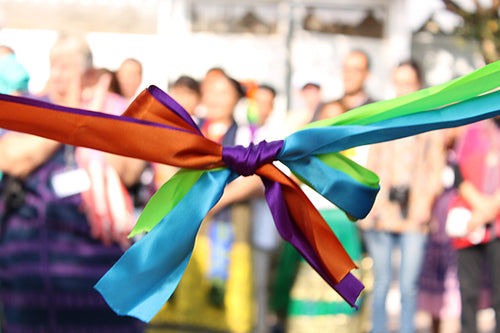
Teofila Avendaño López/Grupo Tixinda de Pinotepa de Don Luis, Oaxaca
Teófila Avendaño is a well-known Mixteco weaver from Pinotepa de Don Luis, Oaxaca. Her work is endangered of disappearing and is exactly the reason why Feria Maestros del Arte was developed.
People don't know it, but among the coastal towns of Oaxaca, the Japanese are everything but popular. The blame for this international displeasure is a mollusk, a small snail whose life passes on the stones that spread on the Oaxacan coast and from whose body a purple tint (purpura) is born. Because of the Japanese, this mollusk has almost disappeared.
The National Commission for Natural Protected Areas (Conanp) has documented that in the early 1980s, Japanese workers plucked snails from their stony existence with an iron hook, smeared the liquid that came from the body of mollusks on silk garments to dye them and then discarded the snails. In the process, the mollusk died or, rather, was killed to obtain beautiful purple kimonos. In five years the species was almost annihilated.
"It was when the purple snail came down. They threw it, they left it in the sun and that mollusk is delicate, you cannot leave it on the hot stone because it dies, because it takes about five minutes for it to adhere to the stone again. Japanese hit the snail in the tower, "recalls Mauro Habacuc Avendaño Luis, a dyer.
The company responsible for the overexploitation was the Japanese company Purple Imperial, which reached an economic agreement with community members in the area to obtain greater volumes and prohibited the Mixtec inhabitants of the place from using the mollusk to dye their traditional clothing, just as they do. From pre-Hispanic times: without killing the snail in the process.
The situation continued until 1985, when dyers from Pinotepa de Don Luis denounced the exploitation, the federal government prohibited this activity to the Japanese and stopped the killing of the mollusk.
Almost 40 years have passed since the Japanese episode, but since then, the snail populations have not fully recovered. Now they face the devastation caused by tourism, its gastronomic use, pollution and climate change.
The scientific name of the purple snail is "Plicopurpura pansa" and its habitat extends to the rocky areas of Bahías de Huatulco. The coveted dye is produced by exposing mollusk fluids to light and oxygen.
Although before dyeing was practiced in other states, now it is only preserved thanks to the Mixotecs from Pinotepa de Don Luis, who have always used it to dye skeins of cotton with which they mainly make the tangle or "pozahuanco", dressed traditional used by women. To do this they use a wooden stake of up to a meter that they take from the root of the mangrove. With it they release the snail from the stone, which releases a transparent liquid and later a white substance, as a defense mechanism against predators.
These substances are the ones that the dyers spread on the cotton skein. In contact with sunlight and oxygen, cotton turns from milky white to yellow, then turns green and finally purple.
With life, the snail is returned to the stone in a part where there is shade and humidity, with the aim of returning it to its habitat. The caretakers of the dye obtain the purple garments and the mollusk is not slain.
Mauro Avendaño was 15 years old in 1956 when he learned the dyeing technique from one of his uncles. For this he walked eight days, from Pinotepa de Don Luis to Puerto Ángel, in search of specimens. "An uncle taught me, I walked with him, so there was no way to go, transportation, communication; the first part where I arrived is Puerto Ángel," he says.
Mauro says that there was a lot of purple snails then. He says that in one day he dyed four 250-gram skeins of cotton and in five days he returned to Pinotepa de Don Luis with up to 20 skeins, each needing the dye of 300 purpura snails. Now, he explains, they can spend up to 15 days looking for the mollusks and return with only four skeins. The scarcity of the species, says Mauro, has translated into a more expensive garment, since a 250-gram skein, which is enough for several blouses or a huipil, can cost around $10,000 or $12,000 pesos.
Gordillo Solís, director of the Huatulco National Park, rules out that the purple snail is in danger of extinction, but accepts that there is a significant decrease in the population found in the region and, therefore, it is a species that is under protection, under the 2010 Mexican standard, something that is repeated in all the places where it lives: in addition to Oaxaca, in a strip that extends from a part of Michoacán and Jalisco, and up to Ecuador.
One of the threats that the species faces in the region is the extraction carried out by the "piedreros", fishermen who are dedicated to the extraction of mollusks such as limpet, dog's tongue and the same purple snail to sell them as food gourmet to tourists. "If you go to the beach. they pass you offering oyster, dog's tongue and you don't really know what you are buying.
Another threat is contamination caused by the increase in tourist activities on beaches such as "El Maguey" and "La Delivery", among others in the Bays of Huatulco; organic pollution, by the lack of water management that causes waste to go directly to the ocean, and by garbage that arrives from the high seas. Added to this adverse scenario is global warming, since the ecosystem where the purple snail lives is subject to periods of humidity, and the increase in temperature causes drying of the rocks and alters marine currents, generating greater pounding of the sea towards its habitat.
In addition, to achieve sustainability, the caretakers take turns every month to dye their skeins of cotton: they go two by two for periods of eight to 15 days, since it is increasingly difficult to find the snail. Caretakers say that staining with the purple snail is only maintained to preserve their culture and for those who value and admire their weaving and dyeing.
You can watch a video about this endangered art on YouTube https://www.youtube.com/watch?v=jOSTGS4ZqdI
Av. Adolfo López Mateos SN
Sección Segunda
Pinotepa de Don Luis, Oaxaca
954 113 0525 WhatsApp

